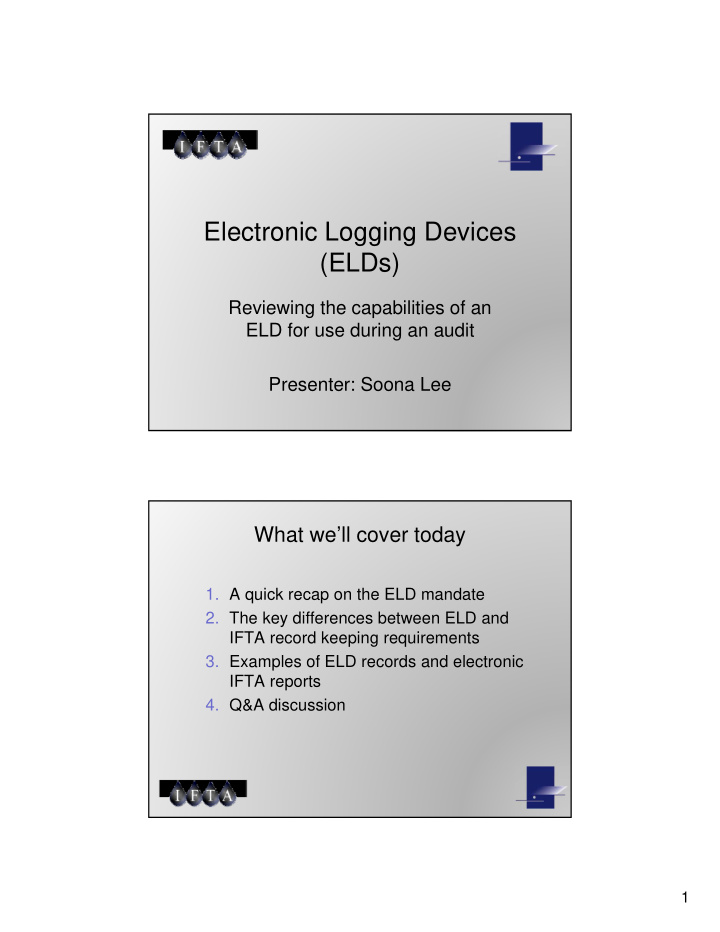



Electronic Logging Devices (ELDs) Reviewing the capabilities of an ELD for use during an audit Presenter: Soona Lee What we’ll cover today 1. A quick recap on the ELD mandate 2. The key differences between ELD and IFTA record keeping requirements 3. Examples of ELD records and electronic IFTA reports 4. Q&A discussion 1
A QUICK RECAP ON THE ELD MANDATE Definition of an ELD § 395.2 “Electronic Logging Device (ELD) means a device or technology that automatically records a driver’s driving time and facilitates the accurate recording of the driver’s hours of service, and that meets the requirements of subpart B of this part.” 2
Key requirements in Subpart B • Integrally connected to the CMV’s engine to automatically track vehicle • Automatically record date, time, location with required accuracy and frequency • Data transfer and backup capability • Detect malfunctions and data diagnostics • Allow annotation and edits by driver and carrier to correct and explain records ELD compliance requirements • Self-certify that ELD meets all technical specifications in Subpart B • Registered with FMCSA https://csa.fmcsa.dot.gov/ELD/List 3
Who needs an ELD? • ELD rule applies to carriers and drivers who are currently required to maintain record of duty status (RODS) • Rule applies to commercial buses as well as trucks, and to Canada- and Mexico- domiciled drivers Who are exempt? • Drivers who operate under short haul exception may continue using timecards; they are not required to keep RODS • Drivers who use paper RODS for not more than 8 days out of every 30 day period • Drivers who conduct driveaway / towaway operation where vehicle is commodity • Drivers of vehicles manufactured before year 2000 4
Implementation timeline AOBRD grandfathering • Per vehicle basis • Can move an existing AOBRD from one vehicle to another • Any new vehicles added to the fleet after Dec 18, 2017 must be equipped with an ELD even if rest of the fleet is on AOBRDs 5
For more info: Refer to FMCSA’s FAQ https://www.fmcsa.dot.gov/hours- service/elds/faqs THE KEY DIFFERENCES BETWEEN ELD AND IFTA RECORD KEEPING REQUIREMENTS 6
Basis of record keeping ELD IFTA & IRP • Individual driver • Vehicles and fleet Qualifying vehicles ELD IFTA IRP • CMV > 10,000lbs • CMV > 26,000 lbs • CMV > 26,000 lbs • Manufactured after Or Or model year 2000 • Three or more axels • Three or more axels • Involved in interstate regardless of weight regardless of weight commerce Or Or • Used in • Used in combination, with combination, with the weight or such the weight or such combination combination >26,000 lbs gross >26,000 lbs gross vehicle or registered vehicle or registered gross vehicle weight gross vehicle weight • Traveling in two or • Chartered buses more IFTA • Traveling in two or jurisdictions more IRP jurisdictions 7
Record retention ELD IFTA IRP • 6 months • 4 years • 5 years Key data records requirement 8
Location data ELD IFTA IRP • At every: • Continuously • Continuously • Change in duty status • Records must be of • Records must be of • Engine on/off quality deemed quality deemed • Beginning and adequate by an adequate by an end of personal auditor auditor use • Intermediate location every 60 minutes (unless when in personal use) Fuel receipts ELD IFTA IRP • Part of supporting • Required records for • Not required documentation IFTA returns 9
Reporting requirements ELD IFTA IRP • Daily ELD logs • Fuel transactions • Distance reporting • Eight days • MPG calculations for monthly, transferred at per vehicle and quarterly and yearly roadside inspections jurisdictions traveled intervals • Six months subject • Distance reporting • Route of travel by to compliance for monthly, vehicle reviews quarterly and yearly • Identify exempt intervals miles • Route of travel by vehicle • Identify exempt miles EXAMPLES OF ELD RECORDS AND ELECTRONIC IFTA REPORTS 10
Example: ELD logs Vendor A Example: Daily trip report Vendor A 11
Example: Monthly summary Vendor A Example: Monthly summary Vendor B 12
Example: Monthly summary Vendor B Example: Fuel transactions Vendor B 13
Example: Monthly summary Vendor C Example: Fuel transactions Vendor C 14
Example: Monthly summary Vendor D Example: Fuel transactions Vendor D 15
Q&A DISCUSSION Soona Lee Director of Regulatory Compliance EROAD Soona.Lee@eroad.com THANK YOU 16
Recommend
More recommend